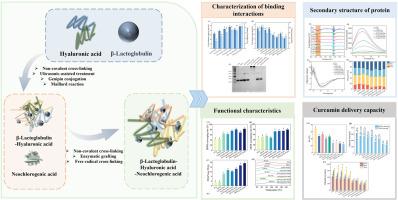β-乳球蛋白-透明质酸-新绿原酸三元配合物交联策略的比较研究:姜黄素传递的结构特征和功能意义
IF 11
1区 农林科学
Q1 CHEMISTRY, APPLIED
引用次数: 0
摘要
为了阐明不同交联方法对三元配合物结构和功能性质的影响,本研究采用非共价交联、超声辅助处理、酶接枝、自由基交联、genipin偶联和美拉德反应六种不同的策略对β-乳球蛋白-透明质酸-新绿原酸(β-Lg-HA-3CQA)配合物进行系统工程。结构和功能分析表明,在结构完整性和功能功效方面,共价策略明显优于非共价和超声治疗。其中,美拉德-酶法的溶度为93.71%,3CQA结合量为73.05 μg/mL,姜黄素包封效率为86.55%。它还显著提高了系统的稳定性,以及它的热和环境耐受性。相比之下,超声波处理只提供了短暂的分散性改善,未能克服非共价配合物固有的结构不稳定性。通过对多种交联方法的系统比较,为优化蛋白质-多糖-多酚复合物提供了理论框架和实践基础,从而提高其功能特性,扩大其在食品和制药领域的应用范围。本文章由计算机程序翻译,如有差异,请以英文原文为准。

Comparative study of cross-linking strategies for β-lactoglobulin-hyaluronic acid-neochlorogenic acid ternary complexes: Structural characteristics and functional implications for curcumin delivery
To elucidate the effects of different cross-linking methods on the structural and functional properties of ternary complexes, this study systematically engineered β-lactoglobulin-hyaluronic acid-neochlorogenic acid (β-Lg-HA-3CQA) complexes using six distinct strategies: non-covalent cross-linking, ultrasonic-assisted treatment, enzymatic grafting, free radical cross-linking, genipin conjugation, and the Maillard reaction. Structural and functional analyses demonstrated that covalent strategies, significantly outperformed non-covalent and ultrasonic treatment in terms of structural integrity and functional efficacy. Notably, the Maillard-enzymatic approach exhibited the optimal performance, with a solubility of 93.71 %, 3CQA binding content of 73.05 μg/mL, and curcumin entrapment efficiency of 86.55 %. It also significantly enhanced the system stability, as well as its thermal and environmental tolerance. In contrast, ultrasonic treatment offered only transient improvements in dispersion and failed to overcome the intrinsic structural instability of non-covalent complexes. This systematic comparison of multiple cross-linking methods provides both a theoretical framework and practical foundation for optimizing the protein-polysaccharide-polyphenol complexes, thereby enhancing their functional properties and broadening their applicability in food and pharmaceutical fields.
求助全文
通过发布文献求助,成功后即可免费获取论文全文。
去求助
来源期刊

Food Hydrocolloids
工程技术-食品科技
CiteScore
19.90
自引率
14.00%
发文量
871
审稿时长
37 days
期刊介绍:
Food Hydrocolloids publishes original and innovative research focused on the characterization, functional properties, and applications of hydrocolloid materials used in food products. These hydrocolloids, defined as polysaccharides and proteins of commercial importance, are added to control aspects such as texture, stability, rheology, and sensory properties. The research's primary emphasis should be on the hydrocolloids themselves, with thorough descriptions of their source, nature, and physicochemical characteristics. Manuscripts are expected to clearly outline specific aims and objectives, include a fundamental discussion of research findings at the molecular level, and address the significance of the results. Studies on hydrocolloids in complex formulations should concentrate on their overall properties and mechanisms of action, while simple formulation development studies may not be considered for publication.
The main areas of interest are:
-Chemical and physicochemical characterisation
Thermal properties including glass transitions and conformational changes-
Rheological properties including viscosity, viscoelastic properties and gelation behaviour-
The influence on organoleptic properties-
Interfacial properties including stabilisation of dispersions, emulsions and foams-
Film forming properties with application to edible films and active packaging-
Encapsulation and controlled release of active compounds-
The influence on health including their role as dietary fibre-
Manipulation of hydrocolloid structure and functionality through chemical, biochemical and physical processes-
New hydrocolloids and hydrocolloid sources of commercial potential.
The Journal also publishes Review articles that provide an overview of the latest developments in topics of specific interest to researchers in this field of activity.
 求助内容:
求助内容: 应助结果提醒方式:
应助结果提醒方式:


